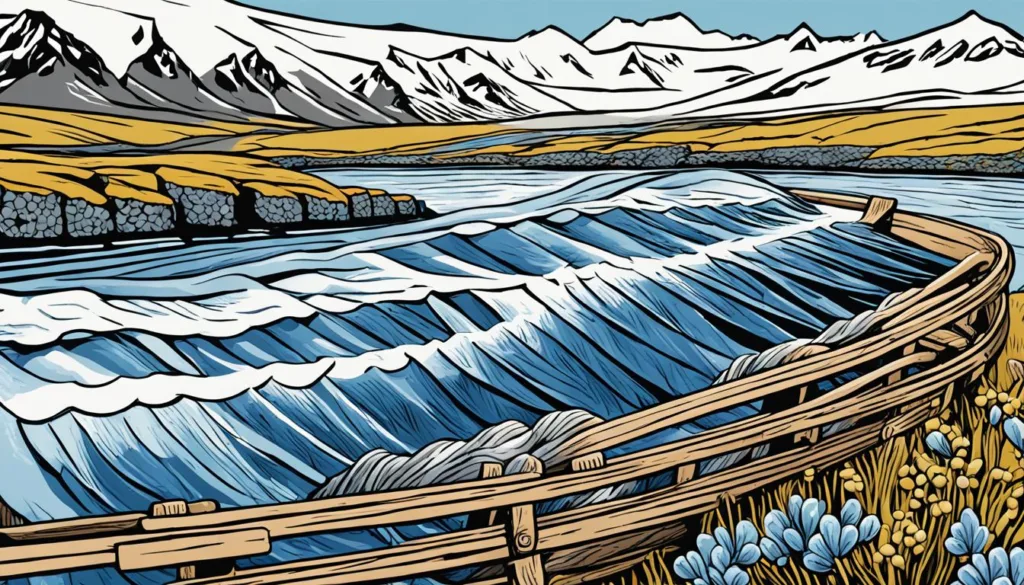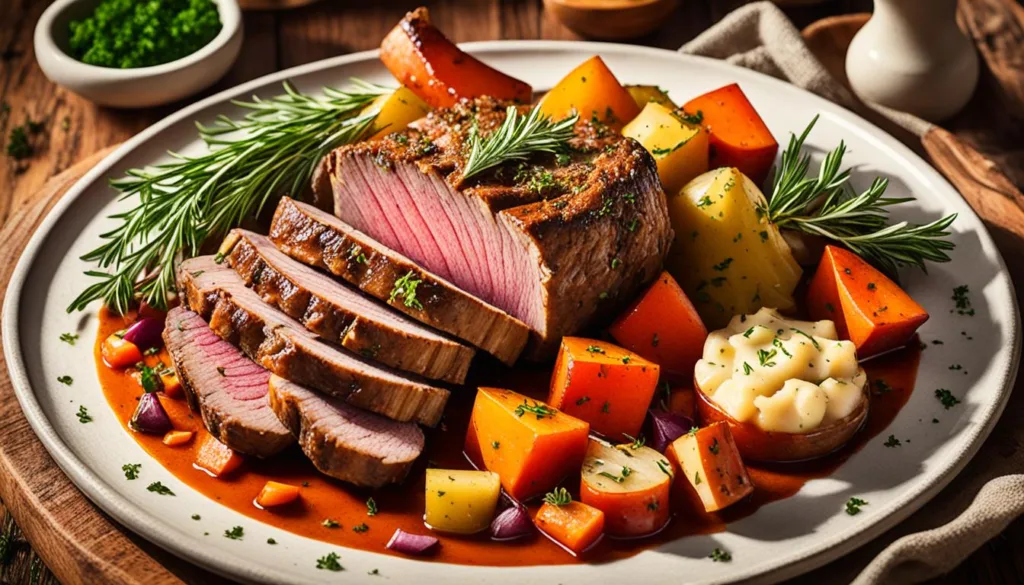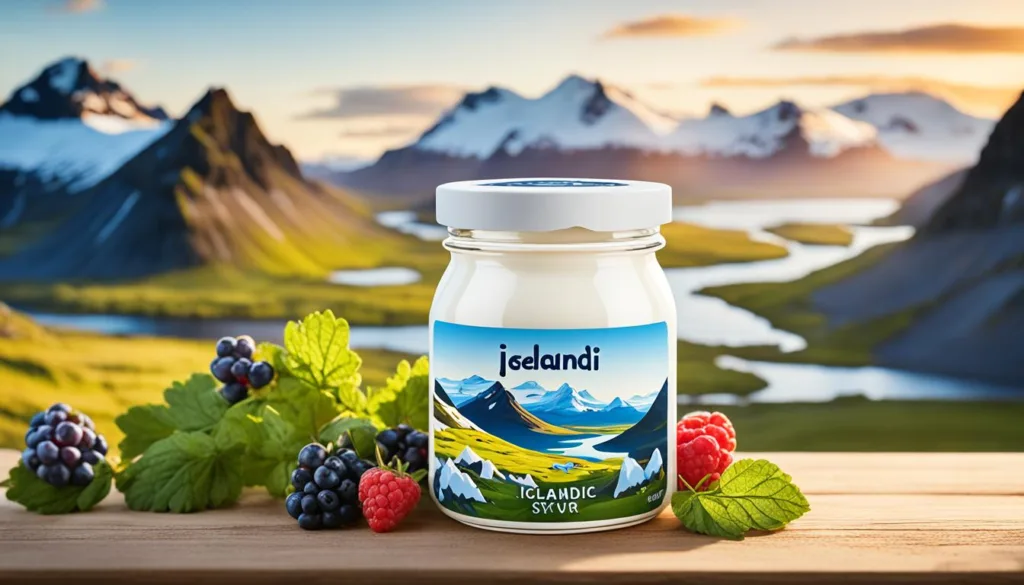Would it surprise you to know that Iceland, a nation with a population smaller than that of Tampa, Florida, stands as a beacon of unique culinary offerings that echo centuries of heritage and survival? From the depths of its volcanic earth comes a treasure trove of Icelandic culinary discoveries awaiting the palate of the adventurous eater. Venture to this island nation, and you’ll explore Icelandic dishes that are as diverse as the landscape itself, from geothermally baked breads to fresh seafood that captures the essence of the North Atlantic’s clean, cold waters.
Diving into the heart of traditional Icelandic cuisine, you find that every bite tells a story—one of Vikings, volcanoes, and a remarkable resilience that has shaped an entire Icelandic food culture. The isolation of Iceland has not only created an ecosystem rich with exotic bird and plant life but has fostered a self-reliant cuisine defined by ingenuity and the purity of local ingredients.
Key Takeaways
- Discover how Iceland’s small population has produced a world-class cuisine with an emphasis on quality and creativity.
- Learn about the role of Iceland’s unique environment in developing traditional food preservation methods and dishes.
- Explore Icelandic dishes that showcase the country’s proud history and adaptability—from sea-kissed lobster to volcanic-baked bread.
- Gain insight into the sustainable practices that continue to shape and redefine Icelandic culinary traditions.
- Experience the richness of Icelandic food culture through the lens of seasoned foragers, fishermen, and forward-thinking chefs.
Introduction to Traditional Icelandic Cuisine
Tracing the unique Icelandic recipes back to their origins reveals a story of endurance and innovation. Surviving the icy winters of this Nordic nation required a deep understanding and mastery of food preservation techniques, which have now become a hallmark of Icelandic culinary traditions. These methods not only sustained the Vikings through harsh conditions but also laid the groundwork for a rich and dynamic Icelandic food blog content that fascinates food lovers globally.
Today’s Icelandic chefs continue to honor this heritage, deftly combining time-honored practices with modern culinary techniques. Geothermal energy, an abundant resource in Iceland, is harnessed to provide a bountiful supply of fresh produce throughout the year, challenging traditional notions of seasonal eating in colder climates. Preservation methods like fermenting, smoking, and curing are now celebrated as artisanal processes, enhancing flavors and creating memorable dishes that connect diners with the storied past of Icelandic fare.
Icelandic culinary traditions are steeped in a history of necessity and resourcefulness. The iconic dishes we see featured on many an Icelandic food blog are the result of this fusion between ancient methods and contemporary tastes. Below is a table showcasing the different traditional techniques still in use today, along with examples of how they contribute to the creation of unique Icelandic recipes.
| Preservation Technique | Description | Example in Icelandic Cuisine |
|---|---|---|
| Fermenting | A process of converting carbohydrates to alcohol or organic acids using microorganisms under anaerobic conditions. | Hákarl (fermented shark) |
| Smoking | Curing food by exposing it to smoke from burning or smoldering material, usually wood. | Hangikjöt (smoked lamb) |
| Curing | Preserving meat or fish by salting, drying, and/or smoking. | Gravlax (cured salmon) |
| Drying | Dehydrating food to eliminate moisture, extending its shelf life. | Harðfiskur (dried fish jerky) |
The practice of these preservation methods is more than just a culinary process; it is a celebration of Icelandic culinary traditions that tells a tale of survival, adaptability, and the splendor of Icelandic nature in every bite. As we delve deeper into the rich tapestry of Icelandic cuisine, each dish unfolds like a chapter from an epic saga, inviting food enthusiasts to partake in a feast of cultural and historical significance.
Icelandic Culinary Discoveries: A Heritage of Hearty Dishes
Delving into the essence of Icelandic food culture, one discovers a cornucopia of rich, comfort dishes that serve as a testament to the island nation’s resilient history and Icelandic culinary traditions. From soothing fish stews to robust smoked meats, these recipes tell stories of inventive survival and the joys of hearty feasting.
Understanding Plokkfiskur – Iceland’s Comforting Fish Stew
A staple in the Icelandic diet, Plokkfiskur, epitomizes the quintessential family meal. The stew’s basic ingredients—fish, onions, and potatoes—are enrobed in a luscious creamy sauce, resulting in a dish that soothes the soul and warms the heart. Through the years, variations of Plokkfiskur have surfaced, with each household imparting their unique touch, whether through the use of different fish species or by adding secret spices handed down through generations.
Hangikjot – The Smoky Flavor of Icelandic Smoked Lamb
As Christmas nears, the scent of Hangikjot, smoked lamb, fills the air in Icelandic homes, signaling the beginning of festive celebrations. This beloved delicacy, characterized by its rich and distinctive smokiness, is traditionally cured and then smoked over sheep dung, allowing the lamb to acquire its unique Icelandic flavor profile. Hangikjot is more than just a meal; it is a cherished cultural icon that unites families during the joyous holiday season.
Drying Traditions: The Snack of Choice with Hardfiskur

Hardfiskur, a naturally air-dried fish, remains a compelling embodiment of Iceland’s innovative spirit in food preservation. Regarded by locals as the Icelandic counterpart to popcorn, Hardfiskur is a crisp, high-protein snack that is both nutritious and satisfying. This minimalist snack, requiring no more than fish and the clean, brisk air of Iceland to cure, underlines the ingenuity that Icelandic people have brought to bear on their culinary craft, making the best of what the environment offers.
Celebrating Icelandic culinary traditions provides a window into the past and a taste of the enduring spirit of Iceland. Through each of these dishes, we come to appreciate the testament of time and the loving dedication to preserving a way of life that honors the formidable natural elements of this unique island nation.
The Role of Seafood in Icelandic Food Culture
Embarking on Icelandic culinary journeys often leads to the cold, clear waters surrounding this subarctic island, where seafood is not merely a meal but a cultural signature. Essential to explore Icelandic dishes is understanding the role that these fruits of the sea play in shaping the best Icelandic food experiences. Humar and herring, each venerated in their own right, are not just staples, but also bearers of tradition and innovation within the Icelandic food landscape.
Luxurious Delights: The Specialty of Icelandic Lobster (Humar)
Nothing quite encapsulates the opulence of Icelandic seafood as does the Icelandic lobster, known locally as Humar. Revered for its tender flesh and ocean-fresh flavor, it is often the centrepiece in Icelandic feasts. The preparation of humar ranges from being simply boiled to elegantly prepared dishes in high-end restaurants, always ensuring a taste of the luxurious side of Iceland’s bountiful seas.
Herring: A Staple from Iceland’s Rich Fishing History
While lobster reigns supreme as a luxury item, herring plays the historical cornerstone in Icelandic cuisine. This fish once fuelled the Icelandic economy and is now making a pronounced comeback on dining tables. Enjoyed alongside hearty staples such as a classic potato salad or dark rye bread, herring exemplifies the traditional essence of Icelandic seafood dishes.
| Seafood Type | Description | Preparation Methods | Cultural Significance |
|---|---|---|---|
| Icelandic Lobster (Humar) | Succulent, small-bodied lobster | Boiled, grilled, in soups or stews | Luxury delicacy highlighting the richness of Icelandic waters |
| Herring | Small, oily fish integral to local fishing history | Pickled, smoked, served with rye bread or potatoes | Once the backbone of the economy, now a traditional favorite |
As you delve into the multisensory experience of explore Icelandic dishes, remember to savor not just the taste but also the history and culture that simmer beneath every bite. The best Icelandic food isn’t just about the flavors on the plate—it’s an immersion into a nation’s love affair with the sea, its past, and its present.
Rugbraud and Laufabraud: The Foundations of Icelandic Baking
In the world of Icelandic baking methods, two bread varieties stand out as cultural staples: Rugbraud and Laufabraud. These two Icelandic bread varieties embody the spirit of traditional Icelandic food, each with a unique preparation and role in Iceland’s gastronomic heritage.

Rugbraud, a beloved sweet rye bread, is renowned for its surprisingly soft texture, avoiding a hard crust through an ingenious geothermal baking process. Authentic to the core, this bread is traditionally baked in the ground near a hot spring, allowing the earth’s own heat to do the work. This cooking method is not only a hallmark of Icelandic baking methods but also a testament to the resourcefulness of Icelandic culture.
Contrastingly, Laufabraud—often referred to as “leaf bread”—presents a delightful crunch as it is intricately carved and then fried, producing a crisp and ornate addition to the festive celebrations, notably Christmas. Both breads offer a taste of history and highlight the diversity within Icelandic bread varieties.
| Bread Variety | Texture | Preparation Method | Cultural Significance |
|---|---|---|---|
| Rugbraud | Soft, Moist | Geothermal baking | Complemented with smoked lamb and pickled herring |
| Laufabraud | Firm, Crispy | Fried after intricate carving | Essential in Christmas feast |
Whether served with a sumptuous spread of traditional Icelandic food or enjoyed on its own, these breads invite both locals and visitors alike to savor the rich flavors and textures that are quintessential to Icelandic cuisine. Next time you marvel at the extraordinary landscape of Iceland, think also of the delectable, time-honored baking traditions that enrich this bold culinary world.
Unique Icelandic Recipes Featuring Lamb
The pastoral landscapes of Iceland are home to a prolific sheep farming culture, playing a pivotal role in the nation’s food traditions. The robust flavor and tenderness of Icelandic lamb allow for a range of unique Icelandic recipes that are mainstays in traditional Icelandic cuisine and represent the essence of Icelandic culinary traditions. Two quintessential lamb dishes – Kjötsúpa and Lambalæri, showcase this perfectly.

Kjötsúpa – A Robust Lamb Soup with Roots in Survival
Kjötsúpa, a celebrated lamb soup, is deeply ingrained in Icelandic heritage. This hearty recipe is crafted with cuts of succulent lamb and an array of locally sourced root vegetables. The soup forms an integral part of Iceland’s culinary identity, symbolizing the ingenious use of accessible ingredients to create flavors that have fortified Icelanders through the ages.
Roast Leg of Lamb (Lambalæri) – The Ultimate Icelandic Comfort Food
Roast leg of lamb, known locally as Lambalæri, is the epitome of comfort food within Icelandic households. This dish is typically prepared with a marinade of native herbs and mosses that complement the naturally rich flavor of the free-range lamb, rendering a succulent and aromatic centerpiece suitable for any festive occasion.
Icelandic Sweets and Confectioneries: Indulge in Local Treats
Embrace the essence of Icelandic delights that go far beyond the savory taste of traditional Icelandic food. Known not just for their robust and hearty main courses, Iceland has an equally tempting array of sugary treats that are deeply embedded in the nation’s culinary traditions.
Skyr: The Versatile Icelandic Yogurt
Rich and creamy, yet distinctively tangy, Icelandic skyr is the pride of Icelandic sweets and an embodiment of nourishment. More than just a yogurt, this nutrient-dense staple, which has graced the Icelandic diet for millennia, now graces tables worldwide. Its texture and versatility make it a favorite topping or base for a variety of desserts or breakfast dishes. Enjoyed traditionally with fresh cream and berries, skyr is a vivid representation of Iceland’s love for simple yet profound flavors.

Kleinur and Bragðarefur: Sweet Partners for an Icelandic Coffee Break
When it comes to coffee breaks, Icelanders know how to make their moments sweeter. The kleinur, a twisted doughnut-like pastry, is a delightful treat often enjoyed amongst friends and family. Alongside, the Bragðarefur, a kind of custom-made ice cream treat loaded with an array of mix-ins, showcases the playful side of Icelandic sweets. Both are perfect examples of how traditional Icelandic food can provide comfort, warmth, and a touch of sweetness during those long Icelandic nights or bright summer days.
- Traditional Skyr: A timeless classic enhancing Icelandic diets
- Kleinur: A satisfying twisted pastry perfect for dipping
- Bragðarefur: A sweet spectacle of ice cream indulgence
Exploring Icelandic Street Food: From Pylsur To Fish Market Finds
For a true taste of Icelandic street food, one needs to savor the iconic Icelandic hot dog, better known as Pylsur. This traditional delight, hailed as one of the best Icelandic food experiences, is not your ordinary hot dog. It’s a delectable combination of lamb, pork, and beef, the taste of which is elevated with an array of condiments, from crispy onions to remoulade.
The rich tapestry of traditional Icelandic cuisine extends to the bustling fish markets and street food stalls dotted around the island. Here, both locals and travelers discover the freshness and authenticity of Icelandic produce. It’s a vibrant spot demonstrating the island’s deep-rooted fish culture, where one can indulge in the freshest fish directly from the cold North Atlantic waters.
- Hearty Fish Soup – A staple found in many street food stalls
- Grilled Fish on Rye – A perfect quick meal for seafood enthusiasts
- Fresh Shrimp Salad – Often found in local markets
Partaking in the street food scene enables visitors to engage with locals and immerse themselves in the genuine Icelandic way of life. With each bite of the savory Icelandic hot dog or the fresh seafood selections, one can appreciate the simplicity and the soul of this unique culinary culture.
Preservation and Innovation in Icelandic Food
The heritage of Icelandic food culture is a poignant reflection of the nation’s ability to adapt and innovate. Nurtured by harsh environmental conditions, the traditional preservation methods of drying, fermenting, and salting have stood the test of time, ensuring that Icelandic cuisine supports itself sustainably. However, this respect for the past does not mean stagnation. The island’s culinary scene has been witnessing a vibrant shift toward sustainable innovation in Icelandic cuisine, bringing forth practices that could very well set the benchmarks for the future of global gastronomy.
From Ancient Techniques to Modern Gastronomy
Leveraging ancient practices, modern Icelandic chefs and food producers are crafting a contemporary food scene that honors ancestral wisdom while embracing current trends and technologies. Culinary innovators are drawing upon the tried-and-true methods of their forebears, using them as a foundation to experiment with flavors, textures, and presentations, creating dishes that not only pay homage to traditional Icelandic fare but also stake a claim on the world gastronomic stage.
Vertical Farming: The Future of Icelandic Fresh Produce
In Iceland, progressive thinking is as much a feature of agriculture as it is of the kitchen. Vertical farming, for instance, is revolutionizing the way Icelanders approach agriculture, particularly the cultivation of fresh produce. This future-forward method allows for year-round growth of fruits and vegetables, free from the constraints of pests and traditional agricultural seasons, all while using less water and space.
| Traditional Method | Modern Innovation |
|---|---|
| Fermenting Shark (Hákarl) | Hydroponic Cultivation of Greens |
| Geothermal Baking (Rugbraud) | Vertical Farming Methods |
| Salting and Drying Fish | Aquaponic Systems for Fish and Vegetables |
| Smoking Meat With Dried Sheep Dung | Renewable Energy Powered Smokehouses |
Indeed, the era of innovation in Icelandic cuisine is here, and it tastefully balances respect for legacy with an enthusiasm for exploration. Whether it’s developing superfoods in sub-zero climes or utilizing volcanic heat to enhance flavors, Iceland continues to chart a path that many around the world watch with avid interest. This small, resilient nation proves that when it comes to food, ingenuity knows no bounds.
Icelandic Culinary Traditions: Beyond the Flavors
Delve into the heart of Icelandic food culture and embark on unforgettable Icelandic culinary journeys that reveal not only a feast for the taste buds but also the soul of a nation. Icelandic food traditions offer a robust tapestry of flavors that have been shaped by the land’s geological bounty and the necessity to endure its climate.
Icelandic cuisine is interwoven with the country’s history, often featuring ingredients that are intimately connected with its survival and sustainability practices. Even the most unconventional dishes, such as Hakarl (fermented shark) and Hrutspungar (pickled ram testicles), are rich in storytelling and cultural significance, showcasing a deep respect for nature’s provisions.
To truly understand the essence of Icelandic gastronomy, one must look beyond the initial reaction to its more exotic offerings and appreciate the layers of history and perseverance that these culinary customs represent. The midwinter festival Þorrablót or the curious consumption of puffin and whale meat all offer a unique window into the Icelandic way of life.
| Traditional Icelandic Dish | Description | Cultural Significance |
|---|---|---|
| Hangikjot | Smoked lamb often enjoyed during Christmas | Evokes the spirit of Icelandic yuletide traditions and respect for locally sourced meats |
| Harðfiskur | Dried fish treated as a snack, likened to jerky | Represents the resourcefulness in preserving food for the harsh winters |
| Þorrablót Delicacies | Fermented shark, sour ram testicles, and other preserved foods | Celebrates Þorri, a month in the old Icelandic calendar, linking cuisine with ancient traditions |
| Skyr | A yogurt-like dairy product enjoyed for centuries | Symbolizes continuity and the passing down of recipes from generation to generation |
Each dish holds a narrative, a lesson in ecology, and an innovative approach to food preparation. Whether you’re a food connoisseur or a curious traveler, traversing the Icelandic food landscape will leave you enriched with stories of survival, community, and the unyielding Icelandic spirit.
As a nation, we have always found ways to make the most of what we have. Our food tells the story of our land and our struggle, but also of our triumphs and celebrations. It is a silent language understood by all who walk our land.
Conclusion
Embarking on a Icelandic culinary journey is akin to traversing through time, embracing both the rich patrimony and the spirited evolution of this Northern nation’s gastronomy. Our exploration of Icelandic dishes has ventured through an array of tastes, from the land and sea, each bite a testament to the resilience and creativity of Iceland’s heritage. As we delve into this edible narrative, we’re reminded that to explore Icelandic dishes is to unmask the soul of this volcanic island, understanding the vital relationship between its people and their environment.
Reflecting on a Gastronomic Adventure in Iceland
From the smoky nuances of Hangikjot to the artistry of local confectioners, our palates have been regaled with the enduring and best Icelandic food. These Icelandic culinary discoveries have showcased not just a flavor profile, but a way of life where food infuses warmth into the subarctic clime. The affection Icelanders have for their Icelandic food culture is handsomely reflected in each creation, infusing modern relevance with a respectful nod to the ancestral.
The Future of Icelandic Cuisine: Trends and Transformations
Looking ahead, the future of Icelandic cuisine is as promising as the first light following the polar night. Fueled by innovation with trends like vertical farming, and the diversification of century-old techniques, Icelandic food culture is not just surviving; it is thriving. Intertwined with tenacity, the epicurean landscape of Iceland is branching out, ready to foster fresh transformations while preserving the touchstones of its illustrious culinary tapestry for future generations of food enthusiasts.






